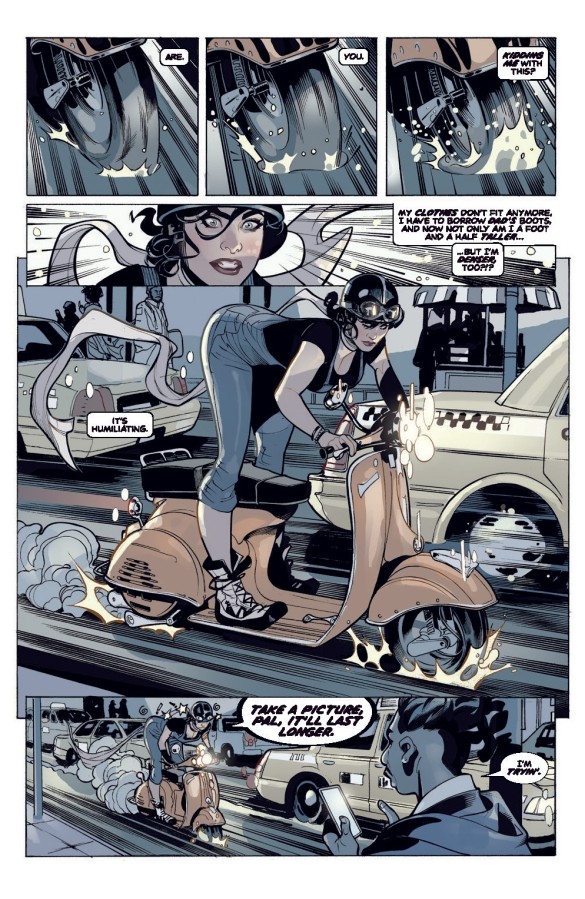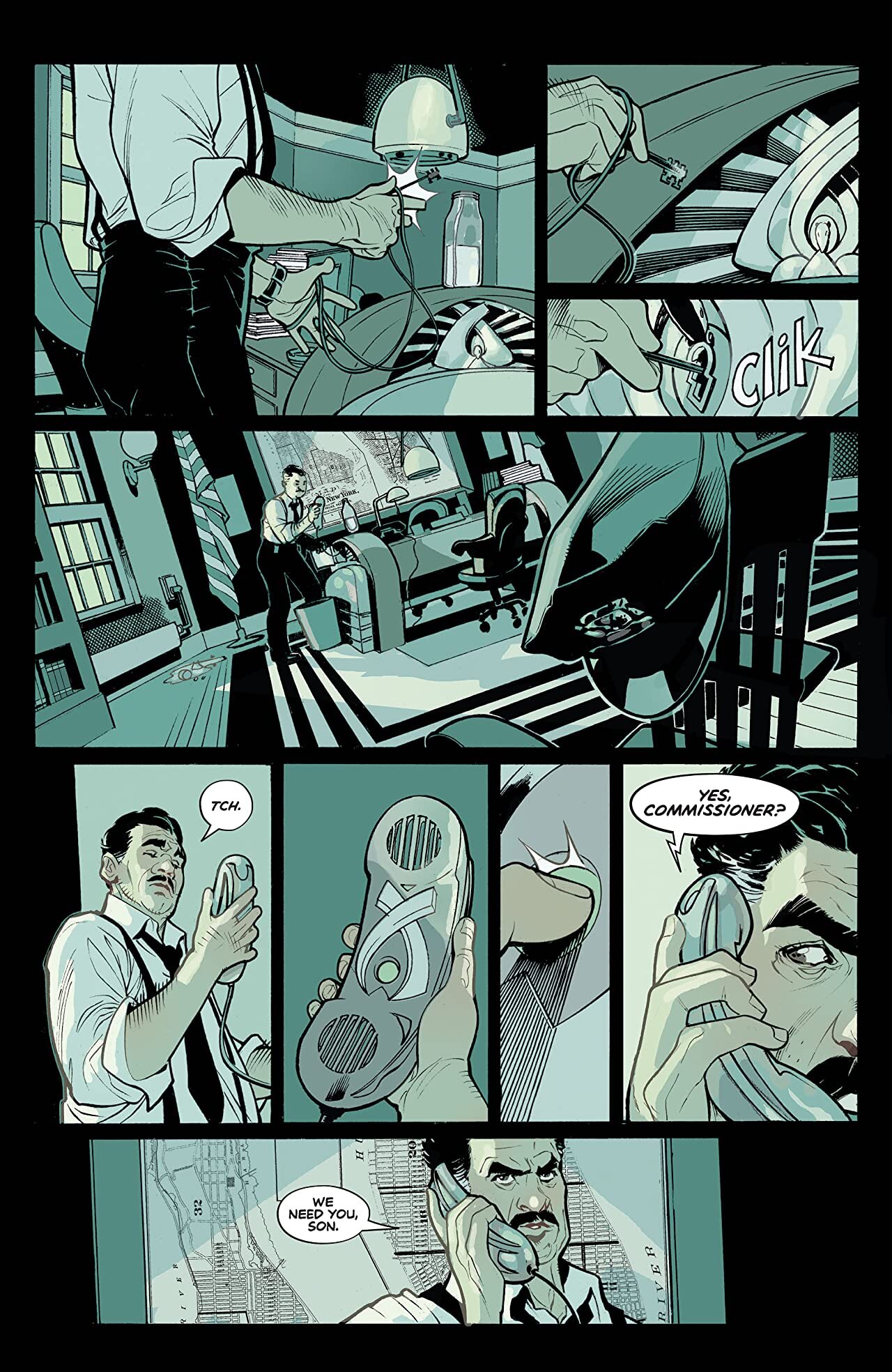Writer: Matt Fraction
Artist: Terry Dodson
Image Comics, 2020

The Moderne (or Machine Age) design ethic took its cue from the multiple geometric element of machines, albeit arranged in a decorative style. Its forerunners were Futurism and Cubism. Futurism glorified the machine (the block shapes of the turn of the 19th century, not the organic shapes we prefer in the early 21st century), and Cubism arranged simple geometric patterns in complex ways. The styles are manifested in old fashioned cinemas (motion pictures achieved popularity at the same time as Moderne came into style), cruise liners, and the New York skyline. American architects Frank Lloyd Wright and Bertram Goodhue pioneered an American Moderne, with interrelated flat and angular geometrical patterns
Machines can be beautiful. Moderne design ethics endeavoured to turn machines into art. Some artists and designers did this by adding chrome shells to machinery – explaining why 1930s architecture consists of so much silver light. There was something fundamentally optimistic about the Moderne design aesthetic. It promised airships, buildings like cathedrals carved of burnished steel, chromed beaks and wings on riveted eagles as we see on the Chrysler Building in New York, the clean lines of the Perisphere and the Trylon of the New York World’s Fair, the triumph of glorious machines. It was bright, shining, and unaware of what was about to befall the world through the rise of fascism and machine-waged war.
We rarely see Machine Age design in comics – an omission perhaps explained by the slow fading from memory of the 1930s. American comic books just post-dated the peak of that design ethic, and during World War 2 comics were filled with inexpensive art and cheaply manufactured for volume consumption. Alan Moore’s Tom Strong (America’s Best Comics, 1999-2006) had the concept, but not the style. Until AdventureMan, the most recent example of Moderne in an American comic book was J.H. Williams III’s dark and dangerous work in Greg Rucka’s wonderful Batwoman: Elegy back in 2009, in which the panels were replaced with lightning bolt bat wings. There is not much pearly hope to be seen in Batwoman: the red and black from the character’s costume, hair and lips contrasts with her dramatically white skin. But the dynamic panel positioning is reminiscent of Rene Chambellan’s 1928 wrought iron and bronze gates in the Chanin building in New York. By way of comparison, here are three examples, and then a picture of the gates:


What is the point of this preamble? In this new title, AdventureMan, published by Image Comics with art by Terry Dodson and written by Matt Fraction, we instead are soaked in Futurist optimism. Glorious Machine Age aesthetics wash through from the title logo, into the covers, and down to the very core of the comic, from Chrysler-esque wings as backdrops, to soaring geometric skyscrapers, to exotic hybrid propeller aircraft:


Mr Dodson’s art has always been beautiful, and we first encountered his work on Marvel Comics’ X-Men titles in 2009. (Watching Mr Dodson’s time lapse videos of his drawings, posted to Instagram, are a delight.) Mr Dodson is especially known for his cover art. This story reflects, with respect, both an exceptional level of artistic proficiency and a love of the Moderne aesthetic.
The art fuels the story. Protagonist Claire Connell is intriguingly quiet. She has layers of characterisation that are revealed over the course of this first volume, slowly peeled back through inner monologue (she is an introvert, preferring the solitude of books to the conviviality of crowds), interactions with family and friends (she is a caring mother and daughter who is overshadowed by her “hyper-achieving sisters”), and third party observations (she is a retired cop who, as a consequence of being injured on duty, suffers from deafness – “That’s just Claire Connell. She used to be one of us.. Once upon a time…”). Like most people, she is many things at once.
Writer Matt Fraction demonstrated his mastery of characterisation with Marvel Comics’ Hawkeye (2012-2015) – imbuing a protagonist with genuinely likeable, quirky qualities such as mild anxieties and a lack of confidence where objectively there should be none. Mr Fraction again deploys that formidable skillset in this title. The family’s interactions are charming – a Shabbat dinner is a lot of fun mayhem, but Claire finds it intimidating. “Getting words in edgewise can feel like gasping for air sometimes. Every one of my sisters bursting with stories, jokes and laughter. Nobody stays quiet for anybody or anything. So being loud isn’t what gets you noticed…” There is a pervasive sense from the inner monologue and her actions that Claire might be suffering from post-traumatic stress disorder.

Claire is also a single mother – beautiful and curvy, but with a pre-teen son. We would never see this with Wonder Woman or Lara Croft. We wonder about that. Why do we see so few mothers in superhero comics? Sue Storm, a key character in Marvel Comics’ Fantastic Four, is the only significant superhero mother which leaps to mind. DC Comics, the other major American superhero publisher, has none. Is it because a mother is unavailable and therefore disinteresting to a male readership? Or because the chores of motherhood are not as exciting as rescuing a hot love interest? Claire reads to her excitable son, Tommy, before bed, gets him to school on time, and engages with him through shared common interests. She is plainly a devoted mother.
Claire is also resourceful and brave. She doesn’t hesitate to side kick a looming dark ghoul made of insects and decay, and outsmarts patrolling robots in AdventureMan’s forgotten building. And that is before she is suddenly and unexpectedly imbued with Adventureman’s height, strength, weight, hypersenses, energy, voice, and “multiversal bloodtype -n”.

The missing character is AdventureMan himself. Clearly inspired by 1930s pulp hero Doc Brass (as was Tom Strong), AdventureMan was seemingly defeated by his nemesis, Baron Bizarre. The only fragment of memory that remains of him are collectable comics. An apocalyptic fight seemingly ends in his death. The initial mystery is what has happened to him and his exotic team. It was a wise choice by Messrs Fraction and Dobson not to make AdventureMan about AdventureMan. Such characters are open cut stereotypes, with almost all glints of originality mined, extracted, and processed. Retaining the focus of the story and the shift of the powerset to Claire was a surprise twist. Claire is not a 1930s damsel-in-distress. Instead, it seems that AdventureMan in his pearly tower fills the roll of Rapunzel.

(The only element to this story which jarred us is an esoteric one. In AdventureMan’s lair is what looks like a piece of the Bayon Temple from Angkor Thom in Cambodia, built in 935, abandoned in the 14th century, and discovered by Westerners in 1914. Those who have visited will be aware that the temple was plundered by Anglophone tomb raiders, evidenced by the English language graffiti “A thief” carved into a stone wall. Surely this was not Adventureman?!)
This is an exhilarating title which pays deep homage to both the Moderne aesthetic and pulp adventure with strong characterisation of the charming, but not charismatic, female lead.
Finally, who dares say that self-promotion does not work? We only became aware of this title because of Terry Dodson’s posts on Instagram.

